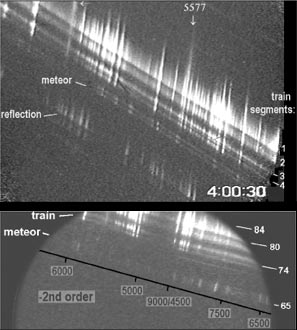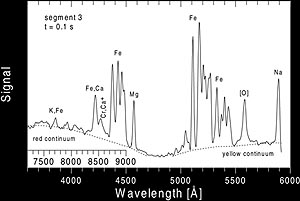|
Leonid MAC |
| home |
| View the shower |
| Mission Brief |
| Science Update |
| Media Brief |
| links |
LEONID DAILY NEWS: November 10, 2000
Meteoric debris is
one of those elusive things that all know exist but nobody every seen it being made.
Small fragments of the meteoroid that somehow survive the plunge
into Earth's atmosphere. Meteoric debris in the form of
small molten spherules are collected from Antarctic ice,
accounting for about 4 percent of all extraterrestrial matter falling to Earth.
Nobody until now has detected the creation of such debris where it occurs: in the path
of a meteor.
Now, Jiri Borovicka and
Peter Jenniskens report the first detection of debris in the afterglow of a bright
fireball. This result is reported in an upcoming special
issue of the journal "Earth, Moon and Planets".
Figures to the right show one frame from
two video records of the spectrum. The animation below shows the video record from the
BETSY spectrograph.
Figure: Visible spectrum of the afterglow, after extraction.
During the 1999 Leonid Multi-Instrument Aircraft Campaign, while flying over the island of Corse,
a fireball as bright as the full Moon appeared at 04:00:29 UT, November 18.
The meteor left a bright glow
intense enough to register on several slit-less spectrographs onboard the FISTA aircraft.
The spectra show a series of parallel images, each representing the afterglow as seen
in a specific color of light emitted by a single atomic species.
The emissions are interupted at least four times with a sharp edge, possibly the result
of spinning of the meteoroid and an uneven breakup.
The sharp edge of the first interuption was found to
drop in altitude by as much as 1.5 kilometers in 1 second before coming to rest.
Such descent points at significant
downward flow along the meteoroid's path immediately after the collision.
The spectrum also shows a continuum emission that is the signature of solid matter.
The shape and position of that red continuum implies a temperature of 1,400 K, which
is the melting temperature of solid ("chondritic") comet matter. This is consistent
with a process of secondary ablation, where atoms evaporate from small debris fragments
that are left in the wake of the fireball. To our knowledge,
this is the first time that the formation of meteoric debris at such high
altitudes has been established.
The relative intensity of the atomic lines trace the gas temperature. Borovicka calculated
that the gas cooled from 4,500 K to 1,200 K within 2 seconds. That appears to be fast enough to
allow the debris to cool before complete evaporation
(Full paper - PDF).
Nov. 10 - Meteoroid debris detected Nov. 09 - New meteor picture Nov. 08 - Spin city Nov. 07 - Meteors affect atmospheric chemistry Nov. 06 - Listen to this! Nov. 04 - Fear of heights? Nov. 03 - The pale (infra-red) dot Nov. 02 - Twin showers Nov. 01 - Leonids approaching Earth Oct. 31 - Prospects for Moon Impact Studies Oct. 30 - Comet dust crumbled less fine Today's news
| ||

 METEORIC DEBRIS DETECTED
METEORIC DEBRIS DETECTED


